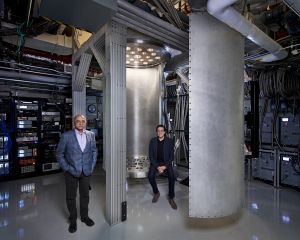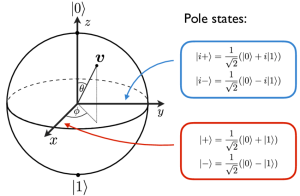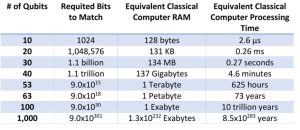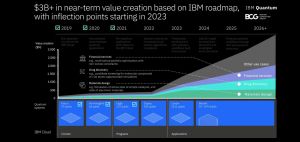Darwin2049/ChatGPT4/PhaseShift
Quantum Computing. Quantum computing is currently making its way into the mainstream computing world. Major industrial giants such as IBM, Google and other smaller entrants such as D-Wave are moving forward briskly at ushering this new technology into the light of day.
Recently IBM announced its IBM Quantum System Two which is based upon their 432 qubit Osprey quantum processor. Google has published a timeline of progress stipulating increasing performance milestones through the 2020’s. Some salient points to keep in mind regarding this topic are that:
- Before/After. Quantum computing will be transformative in all areas of human endeavor. Impacts will emerge that are comparable to the taming of fire, animal husbandry, agriculture and writing.
- Cognitive Prosthetic. Increasingly mainstream quantum computing systems will enable dramatic advances in science and technology. Associated advances will emerge in other areas of human endeavor such as politics, sociology, psychology, economics and geopolitics. An tentative model might be a person with a cognitive expansion capability. This might resemble something like an actively directable form of sub consciousness.
- Composite Systems. Typical high end systems today consist of rows of rack mounted processing systems that are interfaced together for enhanced performance. IBM has publicized that its Quantum System Two will function as an element in a hybrid ensemble. An environment with several dedicated systems will offer novel and unexpected capabilities to users.
- Conformal Cognitive Interfaces. Combining a deep learning based system with optimized user interface systems that excel at voice and video presentation will result in systems that will provide users the experience of interacting with the most knowledgeable people on the planet. These avatar based presentations will be indistinguishable from real people. Calibrating their behavioral traits to make their presentations more human-like will mean that the need for a revision of the Turing Test will become necessary. By way of example early fictitious presentations as well as recent scientific and engineering developments suggests this will become the common reality. Why might this be so?:
- HAL9000. The 1968 movie, a computing system known as the HAL9000 system exhibited behavior that might convince an informed observer that it was conscious. Developments during the course of the movie made clear that it had intentionality and goal seeking behavior. Given today's climate that cautions against alignment risks the HAL9000 system clearly demonstrated that this had been a missing behavioral feature in HAL9000's development. With lethal results. That being so, the movie made ground breaking predictions insofar as HAL9000 was capable of interacting with human via speech. It possessed acute visual and spatial abilities. Moreover and crucially it clearly demonstrated theory of mind. This became evident as it executed a plan of deception. This was made clear when it formulated a plan to mislead the crew and cause them to believe that a crucial component failure had actually happened.
- Sphere. This Michael Crichton novel (which later became a movie) powerfully presented the concept of a cognitive prosthetic that was capable of materializing objects based upon the wishes or desires of a user. A key element in the novel offered the supposition that at some point an advanced extra terrestrial civilization might create technology that can materialize whatever a user could envision. Ultimately the sphere could be considered a cognitive echo chamber. But one with the ability to materialize the users thoughts or wishes. Like HAL9000 it too exhibited no signs of alignment. Rather it was presented as just another tool to be used much as hammers or screw drivers are considered to be merely tools and have no intrinsic means of enforcing any kind of moral or ethical alignment values upon their usages. It exhibited none of the traits associated with consciousness such as sentience, goal oriented behavior, intentionality or consciousness.
- CG4/Watson/TrueNorth (IBM). The IBM corporation has a technology imperative of creating electronic versions of massive neural networks. The current state of play can be seen with the IBM TrueNorth processor. This is a neuromorphic device that mimics the neurological activity of significant swathes of the mammalian cortex. Incorporating this technology into an ensemble of processing elements means that the new systems that will emerge will possess capabilities that rival or even dwarf those of the best humans, animals or combinations thereof.
- Geostrategic Imperatives. The national interest security community has forcefully sounded the alarm about the existential importance of seizing the scientific and technological high ground in the area of quantum computing and artificial intelligence. Going forward the race will escalate between the US and the PRC. Calls to slow or pause advances in deep learning systems will be dismissed as suicidality naïve and shortsighted.
Phase Shift: Gas, Liquid, Solid. Classical physics describes how states of matter possess different properties depending upon their energy state or environment. Thus on the surface of the earth at sea level we experience the atmosphere as an odorless, colorless, tasteless gas. In an environment above the freezing point of water we are unaware of the fact that we inhale and exhale atmospheric gas. It is odorless, colorless and tasteless. Therefore it is difficult if not impossible to imagine that it can condense into a clear liquid.
The previous gaseous or liquid states of water vapor do not prepare us to see solid objects made from this same material.
Looking forward we should expect to encounter very similar kinds of different experiences, i.e. a prior state offers no preparation for encountering a subsequent one.
Transitioning to quantum computing will frequently involve the same kinds of jarring discontinuities. Informed observers have reported that Chat GPT4 required roughly ninety to one hundred days to train using 25000 high end Nvidia GPU devices. This time collapse to minutes or less.
When new knowledge can be incorporated into a quantum based deep learning system on almost a moment’s notice then it suggests that the incorporation of new knowledge on any topic can be almost instantly brought to bear on any problem.
Chat GPT4 allows the user to perform fine tuning for their specific purposes. This suggests that we may see an entirely new ecology arise in very short periods of time. It may be liken transitioning from submitting batch jobs on decks of punched cards to ultra high resolution virtual reality in one step.
The upshot will be that problem that no one has yet even imagined will become soluble in breathtakingly short periods of time.
Working from the premise that new knowledge can be rapidly incorporated into a deep learning system and then fine tuned to specific needs suggests that the entire landscape as it is now known is about to undergo a dramatic shift. By way of a leap of imagination we might see a number of out of date notions reincarnate themselves. By way of imagining just a few:
- Cambrian Explosion. The genie is already out of the bottle. Attempts to reign it back in will prove to be futile. An explosion is likely to result that will defy the best efforts to control or regulate. Therefore we might expect to see a proliferation comparable to that of earlier eras in he development of life on earth.
- Perpetually Morphing Ecology. Widespread availability of deep learning and related technology may well lead to the development of an entirely new ecology. At one end will be government sponsored research facilities and contractors. At the other end of the spectrum we may see the emergence of "one man and his dog" outfits that provide highly specialized niche products or services. An entire new ecology may gradually crystallize as a result. The electronic nature and the instant nature of world wide connectedness may show a reiteration of evolutionary pressures that will morph at speeds far beyond the evolution of software.
- Clerisy. As of 2023 two poles of thought have begun to consolidate their positions on the risks associated with the continued development of advanced artificial intelligence. There is one group that has expressed sentiment that ranges from caution to panic regarding its continued development. The other group has urged focus on the risks of a rival or adversary making advances. In each case the risks are presented as existential.
In a prior era a similar development centered around the Christian church. There were in fact several occurrences of there being a schism between one school of thought and others. Early Christian theology found itself grappling with questions of the Deity and how there could be three different divine yet mortal incarnations of the one God. The Father, Son and Holy Ghost. Another thorny issue related to the question of Transubstantion and its role in the liturgy.
- Council of Nicaea. During the Council of Nicaea these questions were argued vehemently and at length. Ultimately Justinian forced the issue and a consensus was arrived at.
- The Reformation. Martin Luther sparked a revolution in religious thought with his questions that he famously nailed on the door to the cathedral. What the common people knew and were experiencing were summarized in his petition. The results were a firestorm that has echoed and reverberated across the centuries.
- The Pope in Avignon. Political motivations fanned the flames of Papal legitimacy when the French declared that their Pope was the one true legitimate Pope and that the one in Rome was a fraud.
- The Counter Reformation. Alternative interpretations of the Biblical Canon led to the development of unorthodox ways of interpreting the positions found in Biblical texts. Political underpinning insured that these alternative interpretations would consolidate and persist to our time.
- Creedal Legitimacy. The two schools of thought regarding how to press forward with deep learning systems may in many ways echo these early attempts at arriving at an acceptable path forward when dealing with this powerful new technology.
Whereas these first religious wars spanned centuries to play out we should expect to see similar attempts at resolution to happen at warp speed. This assertion is predicated upon the fact that quantum computing based artificial intelligence will enable the materialization of "facts on the ground" that support variously the one camp, ten by turns the other camp. Therefore we might see this happen in record time as the questions of safety are resolved... or deferred.
This process may well show representatives from both schools of thought taking on the traits and characteristics of those seen in the past. For instance in the Christian world a foundational document served the purpose of being the source from which all discussion and dispute arose. This was the Christian Bible. In this newer incarnation we might expect to see comparable foundational documents become the basis for recognizing issues and resolving disputes.
In each case there will be leading voices. There will also be "chorus sections" that echo the central positions of each camp. We might also expect that there will be outlier actors who espouse some but possibly not all of the positions of a school of thought and may act as maverick-type voices. They might be likened to the emergence of the cardinal class from the bishopric class.
- Spirits. A meme that regularly surfaces is the speculation that a so-called artificial general intelligence-type capability may be momentarily upon us. This capability has been characterized as a disembodied overarching intelligence capable of answering any question that humans can pose to it. In prior times this kind of capability might have been labeled as a deity or some kind of god-like being. The reality is that the potential risks are in fact real - within limits. This is because of the ability to enable such a cognitive prosthetic connection to various forms of fabrication systems or manufacturing centers can result in the creation of novel materials, chemicals or other biological constructions of which few or no humans might even be aware of. Wikipedia might be considered a forerunner to what eventually might come to be called spirits. Currently knowledge sources such as Wikipedia has experienced a number of claims and assertions regarding the validity of its sources and the political/sentiment biases of various of its entries. A spirit might come to evolve into a specialized source of knowledge that grows organically with use. It might be accessible using basic human communications skills such as speech or similar symbolic representations, e.g. imagery, video, various combinations. As these gain acceptance we might see them developing followings and adherents. Should such a pathway forward become accepted then we may see the emergence of specialists comparable to clerics from earlier times such as imams, rabbis, bishops and cardinals.
- Oracles. In the classical Greek worldview the deity Apollo used a woman known as the Oracle to provide insights and predictions. The oracle received local visitors as well as those from far away. They would pose questions to her on a variety of issues from personal to questions of diplomacy and war. Her pronouncements were often couched as riddles for the questioner to decipher. Current users of CG4 issue queries to it on all manner of topics. More recently the art and science of formulating queries has refined with the advent of what are known as super prompts. These super prompts are constructed as a series of qualifications and refinements. The result is that the output from CG4 can be substantially more useful, well structured and focused than a simple prompt might provide. Looking forward we should expect to see additions being made to CG4 by the OpenAI organization itself. Individuals and enterprises are already able to submit their own fine tuning information and knowledge. The ability to increasingly fine tune the capabilities of CGR4 suggests the possibility of having individuals or teams that offer increasingly refined and targeted performance.
- Philosophes.
- Orthodoxy, Heterodox, Heretics, Revisionists, Protestants, Orcs.
- Cardinals, Bishops, Prelates, High Priests.
- Guilds. Existing professional organizations are an outgrowth of mediaval guilds. These were essentially trade specific collections who gradually articulated and promulgated standards and practices. Typical guilds were stone cutters and masons or woodworkers. Other skill groups emerged that were specific to metal working or such specialties as wheelwrights. Food storage became a valuable skills with the eventual development of coopers who were able to offer efficient wooden structures as barrels.
- Specialists: Alchemists, Sorcerers, Magicians, Wizards, Apprentices, Jesters.
- .
- Smiths, Masons, Wheelwrights, Coopers.
- Mentats. The sixties Frank Herbert novel Dune featured a range of humans with unique and exceptional skills. A significant capability were those humans who were trained to perform calculations of mathematics, logic and other tasks that would be considered only possible using a modern electronic computer. The infrastructure is already in place to approach this kind of skill. A user with a voice input capability and a mobile fone connection can connect to their dedicated cognitive prosthetic and query it verbally. By being able to query a cognitive prosthetic from any location means that a class of individuals may emerge that are adept at posing highly specific and exact queries to their cognitive prosthetic and offer responses in real time.
- Samurai, Ninjas, Ronin.
- Katsas, Kidon, Sayanim.
- Pied Pipers, Horse Whisperers, Snake Charmers, Jugglers, Chanteuses, Muses. Social media and similar popular channels of information have shown the rise of individual known as influencers. These are individuals who provide reliable impressions on specific topic areas. Common topic areas might involve cuisine, attire or leisure. Other more targeted areas such as legal or financial advice will become increasingly available.
- The Krell.
Quantum Mechanics. The brief items that follow are deliberately kept brief because a discussion of the mathematics and physics underpinning quantum computing is beyond the scope of this discussion. This is because the topic area obliged a deep understanding and conversance with very advanced mathematics and physics.
Quantum computing mechanisms due to their inherent nature are capable of solving problems that are beyond any current or foreseeable classical computing architecture.
There are various reasons why this is the case. Quantum computing as the name suggests is grounded in the quantum world. Understanding quantum physics requires the most advanced grounding in physics and mathematics. Therefore we provide only a cursory introduction to some of the more basic elements. Additional definitions can be found via the link at the end of this page.
Advanced mathematics is advised for those wishing to further understand the crucial elements of entanglement, coherence, vector spaces or quantum algorithms.
What can be said currently however is that this new computational environment will make possible solution to currently intractable problems soluble within acceptable time frames. The ability to do so will invariably carry with it great promise but also great risk.
- Superposition. Quantum computers are capable of performing calculations that are beyond the scope of classical computing devices. This arises from the quantum reality of superposition. This means that an object at the quantum level has two factors that can be measured: momentum and location. At any instant a quantum system can be in all possible definable states. The act of attempting a measurement will result in the collapse of this superposition state and result in returning a specific value. But this also means that only one factor can be known at the moment of measurement EITHER the position of the object or its momentum - but not both. This arises due to the Heisenberg's Uncertainty Principle.
- Coherence/Decoherence. A crucial factor that conditions the utility of a device operating at the quantum level is noise. Any kind of noise from heat, vibration or cosmic rays can disrupt the extremely delicate processes at the quantum level. Therefore when numbers are presented they are often not well differentiated into qubits that can perform useful computations relative to those that do not. A strategy for dealing with this problem has been to use large numbers of qubits as an error correcting means. Therefore when a quantum device is said to consist of over a thousand qubits then in fact it might have to use 90% of them just for maintaining quantum coherence and entanglement. In order to get meaningful results these quantum states must be maintained for the duration of the calculation. But at these levels and using this means the result is that calculations happen at scales far beyond merely electronic or even photonic speed but due to quantum realities multiple evaluations can happen in parallel. The result has been the dramatic speed up numbers that have recently been reported in various research labs and corporations. Therefore a quantum computer that is claiming to have one hundred or more coherent qubit capability means that they can outperform classical computers by very wide margins.
- Entanglement.
- Wave-Particle Duality.
- Heisenberg's Uncertainty Principle. Werner Heisenberg was the developer of the now famous Heisenberg Uncertainty Principle and won the Nobel prize for his discovery in 1927. His principle essentially stated that at the micro level of reality (i.e. atomic or subatomic) one can only measure the position OR the momentum of a particle. But because of the particle/wave duality nature of all matter it is impossible to measure both. Should we attempt to pinpoint the location of a particle we might discover its precise point at a specific moment in time but we can NOT know its momentum. Conversely we might measure its momentum or energy state but we can NOT know its position. The reality of the world at the quantum level is inherently counterintuitive. However innumerable physics experiments have demonstrated beyond doubt that this is the reality in which all material objects exist.
The interested observer can find a number of useful references addressing the topics of quantum bits, entanglement and superposition
In some cases they will prove to be fairly technical.









